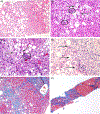AASLD Practice Guidance on the clinical assessment and management of nonalcoholic fatty liver disease
- PMID: 36727674
- PMCID: PMC10735173
- DOI: 10.1097/HEP.0000000000000323
AASLD Practice Guidance on the clinical assessment and management of nonalcoholic fatty liver disease
Conflict of interest statement
CONFLICTS OF INTEREST
Brent A. Neuschwander-Tetri consults/advises Akero, Arrowhead, BMS, Clinical Care Options, GSK, Glympse, Hepion, High Tide, HistoIndex, Labcorp, LG Chem, Madrigal, Merck, Sagimet, Senseion, Target RWE, 89Bio, has stock options with HepGene, HeptaBio and receives research grants paid to his institution from BMS, HighTide, Intercept, Inventiva, Madrigal. Mohammad S. Siddiqui consults/advises Sagimet and AMRA. Manal F. Abdelmalek consults/advises 89 Bio, Bristol-Myers Squibb, Hanmi, Intercept, Inventiva, Madrigal, Merck, NGM Bio, Novo Nordisk, SonicIncytes, Theratechnologies, Fishawack Inc., Terra Firma Inc. and receives research grants paid to her institution from Allergan, Boeringher- Ingelheim, Bristol Myers Squibb, Celgene, Durect, Enanta, Enyo, Galmed, Genentech, Gilead, Hanmi, Intercept, Inventiva, Madrigal, Novo Nordisk, Poxel, Target NASH, Viking. Stephen Caldwell receives research support from Gilead, Galectin, Madrigal, Prometheus, Exact, GenFit, Inventiva, Zydus, Durect, Royalty, Avanos. David E. Kleiner is an unpaid consultant/collaborator with HistoIndex and HighTide. Rohit Loomba serves as a consultant to Aardvark Therapeutics, Altimmune, AstraZeneca, Eli Lilly, Inipharma, Intercept, Ionis, Madrigal, Novo Nordisk, Pfizer, Sagimet, Theratechnologies, 89 bio, Takeda, Terns Pharmaceuticals and Viking Therapeutics. Co-founder of LipoNexus Inc. The remaining authors have no conflicts to report.
Figures




Comment in
-
Letter to the Editor: People living with HIV and NAFLD-A population left behind in the global effort for liver fibrosis screening?Hepatology. 2023 Nov 1;78(5):E87-E88. doi: 10.1097/HEP.0000000000000465. Epub 2023 May 19. Hepatology. 2023. PMID: 37199181 No abstract available.
-
Letter to the Editor: Updated guidance on NAFLD screening.Hepatology. 2023 Nov 1;78(5):E89-E90. doi: 10.1097/HEP.0000000000000462. Epub 2023 May 19. Hepatology. 2023. PMID: 37199219 No abstract available.
-
Letter to the Editor: ELF in the risk stratification of NAFLD-Are the ELF thresholds suggested by the AASLD guidelines appropriate?Hepatology. 2023 Dec 1;78(6):E101-E102. doi: 10.1097/HEP.0000000000000464. Epub 2023 May 22. Hepatology. 2023. PMID: 37203218 No abstract available.
-
Reply: People living with HIV and NAFLD and updated guidance on NAFLD screening.Hepatology. 2023 Nov 1;78(5):E91-E92. doi: 10.1097/HEP.0000000000000469. Epub 2023 May 22. Hepatology. 2023. PMID: 37203291 No abstract available.
-
Practice guidance documents for the diagnosis and management of non-alcoholic fatty liver disease-recent updates and open questions.Hepatobiliary Surg Nutr. 2023 Oct 1;12(5):780-784. doi: 10.21037/hbsn-23-376. Epub 2023 Sep 18. Hepatobiliary Surg Nutr. 2023. PMID: 37886211 Free PMC article. No abstract available.
References
-
- Chalasani N, Younossi Z, Lavine JE, Charlton M, Cusi K, Rinella M, et al. The diagnosis and management of nonalcoholic fatty liver disease: practice guidance from the American Association for the Study of Liver Diseases. Hepatology. 2018;67:328–57. - PubMed
-
- Cusi K, Isaacs S, Barb D, Basu R, Caprio S, Garvey WT, et al. American Association of Clinical Endocrinology Clinical Practice Guideline for the diagnosis and management of nonalcoholic fatty liver disease in primary care and endocrinology clinical settings: co-sponsored by the American Association for the Study of Liver Diseases (AASLD). Endocr Pract. 2022;28:528–62. - PubMed
-
- Pons M, Augustin S, Scheiner B, Guillaume M, Rosselli M, Rodrigues SG, et al. Noninvasive diagnosis of portal hypertension in patients with compensated advanced chronic liver disease. Am J Gastroenterol. 2021;116:723–32. - PubMed
Publication types
MeSH terms
Grants and funding
LinkOut - more resources
Full Text Sources
Other Literature Sources
Medical

